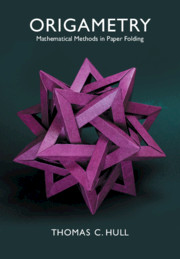12 - Rigid Origami
from Part IV - Non-flat Folding
Published online by Cambridge University Press: 06 October 2020
Summary
Rigid origami describes origami where each face of the crease pattern is flat, as if made from stiff metal.Modeling rigid origami with matrices allows one to describe materials that have been folded into a three-dimensional shape, as opposed to flat origami.This chapter describes this matrix model and proves its key features.In addition, a generalization of Maekawa’s Theorem for three-dimensional rigid origami is introduced, as is modeling rigid origami with the Gauss map from differential geometry.The latter turns out to be a useful tool for the remainder of the book.
Keywords
- Type
- Chapter
- Information
- OrigametryMathematical Methods in Paper Folding, pp. 231 - 255Publisher: Cambridge University PressPrint publication year: 2020

